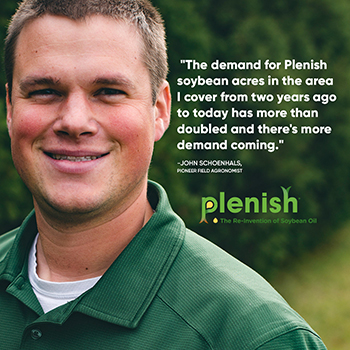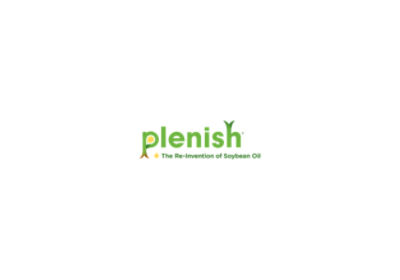Creating market demand for a new product takes time and investment but for high-oleic soybeans the work is starting to pay off. "We used to have a prior issue of lack of interest by end users," recalls John Jansen. "Now we have more end-use interest than we have the ability to supply [in 2021]."
Jansen is vice president of strategic partnerships for the United Soybean Board, and he's watched the market for high-oleic soybeans evolve over the last several years. He notes that even with year-over-year growth in acres topping 100%, supply is not matching demand. That's a great problem to have in any market, but he also notes missing a sales opportunity makes it difficult to go back to that buyer.
Farmers may have heard of high-oleic soybeans for the last few years. For example, Pioneer® brand Plenish® high oleic soybeans have been growing acres for some time. But what makes the oil from high-oleic soybeans more popular in food and industrial applications? There are three key areas where high-oleic oil offers benefits.
High-oleic soybean oil: A versatile performer
1. The product is more stable. The oil is high in monounsaturated fats, and low in polyunsaturated fats. In high-heat applications the oil is less likely to create polymers that build up on restaurant equipment, reducing cleaning and operating costs. In fryer applications, the product has a longer use life than standards vegetable oils, cutting costs for restaurants.
2. Fewer additives. In many applications it's possible to use high-oleic soybeans and remove other additives in the final product. That's due in part because high-oleic oil makes foods more shelf-stable, requiring less added antioxidants to preserve shelf-life. It also allows food makers to use more "clean labels" with less antioxidant additives. "This is a fundamental driver for consumers," Jansen says.
3. Industrial applications. High-oleic soybeans can replace petroleum-based products in some industrial uses. For example, they can be used as a surfactant and they're biodegradable. "It's all about environmental stewardship and consumer perception," Jansen adds.
There's also a change in the petroleum market which may reduce supply of certain feedstocks in off-shoot markets. If petroleum production declines, many byproduct streams including waxes and coatings may dry up. This opens the door for bio-based replacements, and high-oleic soybean oil could play a role.
"Even with year-over-year growth in acres topping 100%, supply is not matching demand."
Short answer? The demand for high-oleic soybean oil is not declining any time soon. And it's an opportunity for farmers to earn a premium too.
A soybean income boost for farmers
"The demand for Plenish soybean acres in the area I cover from two years ago to today has more than doubled and there's more demand coming," says John Schoenhals, Pioneer field agronomist. Schoenhals works in northern Ohio.
At one time, there was a balancing act for this new soybean oil market. Farmers who wanted to enter this segment of the identity-preserved soybean business were expressing interest, but that demand was ahead of available seed production. Today that scale has tipped the other way and Schoenhals says there's enough seed in a wide range of maturity zones for farmers interested in the product.
In addition, several processors offer premium programs, including ADM, Bunge, CHS, AGP and Perdue, providing added income. Premiums range from $0.70 to $1.30 per bushel depending on the region, and delivery requirements for specific buyers. "This offers farmers an added revenue source and an opportunity to get more revenue per acre of land," USB's Jansen adds. "The premium might be more attractive with $8 soybeans, but even at $15 soybeans it's a real opportunity to add value."
Getting into identity preserved products raises some agronomic questions. Farmers don't want to take a hit on production that could wipe out the value of a premium. "These [Plenish] soybeans are Pioneer® brand A-series soybeans and they yield with our best soybeans with other technologies," Schoenhals says. "That's a huge selling point for us."
Schoenhals says there's a soybean research and breeding station in Northern Ohio, and he notes these soybeans are bred with traits to perform in the region, which is true of varieties developed in other geographies. "The [Peking] soybean cyst nematode traits and disease tolerance traits are even better than some other soybeans we sell," he notes. "These are fantastic from an agronomic standpoint."
"This offers farmers an added revenue source and an opportunity to get more revenue per acre of land." — John Jansen, United Soybean Board
One area he offers some insight is for weed control. At this time, Plenish soybeans have glyphosate resistance, but no other herbicide resistance traits. That requires a little more management, but not so much to overcome the premium, Schoenhals says. "We are working to bring high-oleic soybeans to market that have more herbicide tolerance traits, including Enlist® E3 soybeans," he says.
Consumers are increasingly aware of the food they eat and the health profiles of the fat sources they consume. High-oleic soybean oil is filling that growing need. "The industry is looking to continue expanding supply, and if we can get over 1 million acres this will take on a life of its own," Jansen says. "We'll approach that in 2022."
This content produced by Farm Progress for Corteva Agriscience.
Get more information on program specifications and delivery here.


